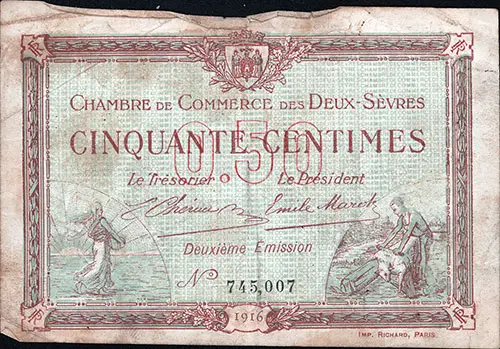📜 World War I Documents & Archival Collection: Military Orders, Draft Records, Soldier Diaries & More
📌 Explore the World War I Documents & Archival Collection, featuring draft registration cards, soldier diaries, official military orders, and war correspondent letters. A vital resource for historians, genealogists, teachers, and students, uncovering firsthand accounts of WWI service, leadership, and wartime economy.
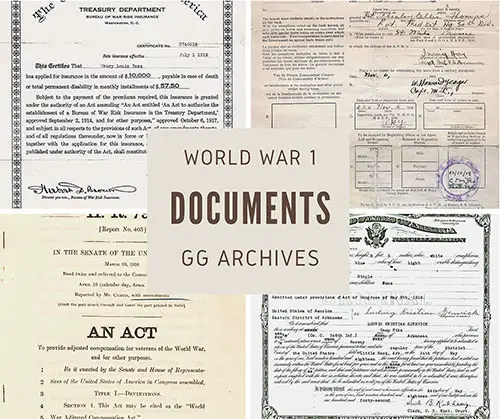
📜 Documents of World War I Archival Collection: A Treasure Trove for Historians, Educators, and Genealogists
📖 The Significance of WWI Documents
The World War I Document Collection at the GG Archives is an invaluable resource for anyone researching military history, genealogy, wartime journalism, and economic conditions during the Great War. This comprehensive collection includes official military documents, personal correspondence, pay records, war passes, and more, offering a firsthand look at the lives of soldiers, war correspondents, and civilians affected by the conflict.
This document collection is particularly useful for historians, educators, students, and genealogists, providing primary source materials that enrich our understanding of World War I and its lasting impact.
The GG Archives has many documents on World War 1, including many of the papers genealogists and family historians will come upon during their research. Our extensive document collection is helpful for students studying the Great War and teachers seeking primary source documents to enhance their lessons.
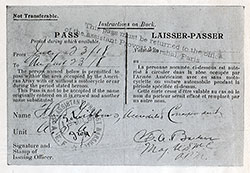
Floyd Gibbons Correspondent Pass
The bearer, Floyd Gibbons, is authorized to accompany the American Expeditionary Forces in France as an accredited correspondent representing Chicago Tribune, subject to the regulations for Press Correspondents.
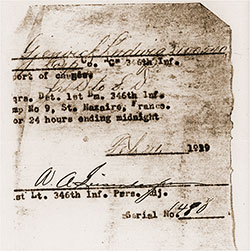
Leaves of Absence, Passes, and Furloughs: General Orders No. 6 HQ AEF, France - 1918
General Order No. 6, issued by Brigadier General James C. Harbord by Command of General Pershing, provides instructions for handling Leaves of Absence, Passes, and Furloughs in France for the AEF dated 8 January 1918.
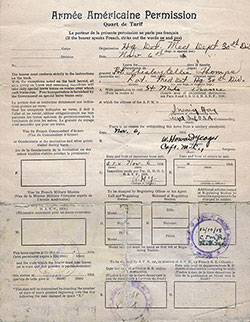
Leave Permit for American Soldier in France
With the exceptions noted on the back, all men going on leave and returning from that place will take only special leave trains on routes over which such trains run. Free transportation is furnished by the Government on special leave trains only.
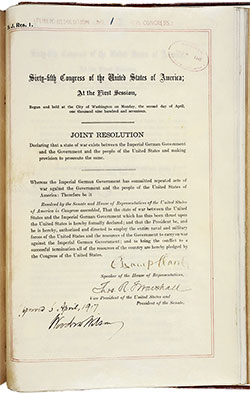
Joint Resolution Declaring A State of War Exists Between Germany and the US - 2 April 1917
When President Wilson signed this joint resolution of the houses of Congress, the nation was officially declared to be at war with Germany.
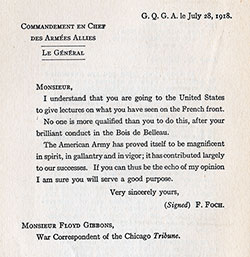
Letter from General Foch to Floyd Gibbons - 1918
Letter, in French with English translation, dated 28 July 1918 from General Foch, Commander-in-Chief of the Allied Forces to Mr. Floyd Gibbons, War Correspondent for the Chicago Tribune.
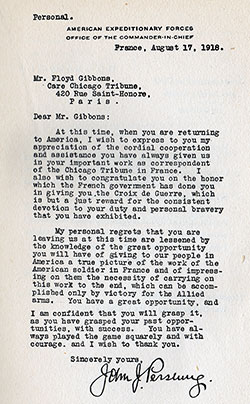
Letter from General John J. Pershing to Floyd Gibbons - 1918
Personal Letter dated 17 August 1918 from General John J. Pershing, Commander-in-Chief of the American Expeditionary Forces to Mr. Floyd Gibbons of the Chicago Tribune.
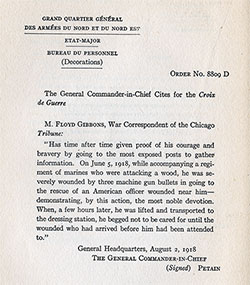
Letter from General Pétain to Floyd Gibbons, 1918
Letter Dated 2 August 1918 From General-in-Chief Philippe Pétain to Mr. Floyd Gibbons, War Correspondent for the Chicago Tribune.
💶 Wartime Money: French Currency Used by WWI Soldiers in France (1916-1918)
During World War I, soldiers stationed in France used French francs and emergency notes issued by the Chambre de Commerce. This article examines two key denominations from 1916—the 50 centimes and 1 franc banknotes—which offer insight into the economic challenges faced by soldiers, the devaluation of currency, and the long-term financial effects of the war.
This historical artifact is invaluable for historians, students, teachers, and genealogists, providing a tangible connection to how soldiers managed their daily expenses and the financial realities of wartime France. The devaluation of the French franc due to wartime inflation, post-war economic instability, and currency pegs make this a fascinating study in wartime economics.
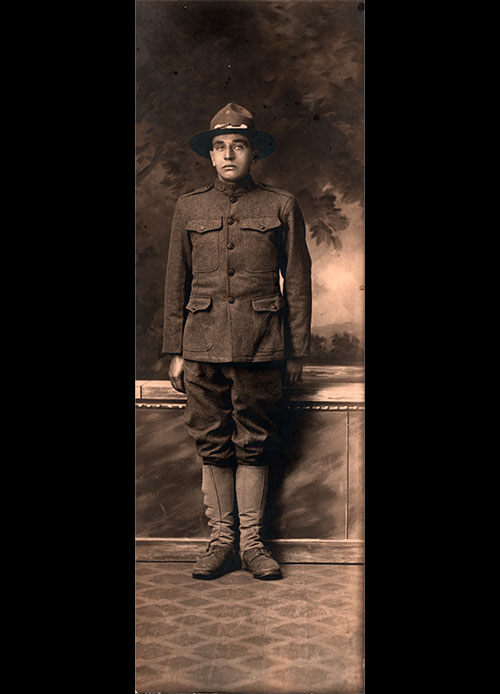
🪖 WWI Soldier’s Diary (1917-1918): An Immigrant’s Journey from Minnesota to the Western Front
This extraordinary diary of Corporal Ludvig Kristian Gjenvick, a Norwegian immigrant turned U.S. soldier, offers a vivid, firsthand account of World War I, his military service, and his journey from Minnesota to the battlefronts of France.
Ludvig Gjenvick’s story is particularly valuable for teachers, students, historians, and genealogists, as it provides a rare personal perspective on the war, the immigrant experience, and the everyday struggles and triumphs of soldiers in the American Expeditionary Forces (AEF).
🔹 This article is a treasure trove of historical insights, detailing life as an immigrant soldier, the war’s impact on soldiers and civilians, and the importance of first-hand military accounts.
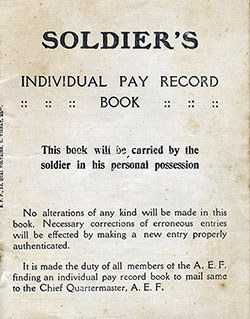
Soldiers Pay Record Book - 1918
A Pay Record Book of Sgt. 1st Class Harry B. Coulter. The printed instructions on the pay book will be followed so that soldiers may promptly receive the pay due them, and payrolls will be made up from data in the pay book.
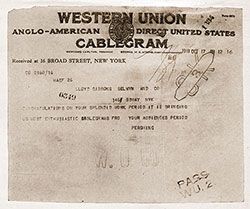
Third Army Corps Cablegrams - 1918
Memorandum to Officers and Men of the Third Army Corps from Major General R. L. Bullard and Cablegram from General John Pershing to Floyd Gibbons, 1918.
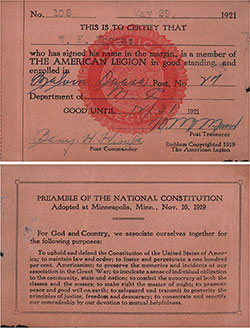
American Legion Membership Card
WWI era American Legion Membership Card issued to W. E. Thomas, No. 108, 29 May 1921, who had signed his name in the margin, is a member of The American Legion in good standing, enrolled in Post No. 27.
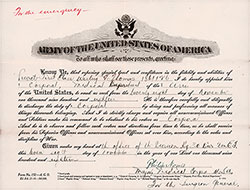
US Army Promotions and Appointment Certificates
Certificates of Promotion to Corporal in the Army and National Army of the United States of America, for soldiers appointed to their new rank during World War I.
📌 Key Highlights of the Collection
📰 The Role of War Correspondents: Floyd Gibbons and His Frontline Reports
✔ Floyd Gibbons’ Correspondent Pass (June 23, 1918)
🔹 Issued by the American Expeditionary Forces (AEF), this pass granted Gibbons permission to accompany U.S. troops in France as a war correspondent for the Chicago Tribune.
🔹 Highlights the importance of war journalists in shaping public perception of WWI.
✔ Letters from Top Military Leaders to Floyd Gibbons
🔹 Marshal Ferdinand Foch (July 28, 1918), General John J. Pershing (August 17, 1918), and General Philippe Pétain (August 2, 1918) all personally corresponded with Gibbons.
🔹 These letters reflect the critical role of the press in wartime communication and propaganda efforts.
🔹 Why This Matters: This section is *invaluable for students, teachers, and historians exploring media influence, wartime journalism, and the role of correspondents in shaping public opinion during WWI.
📜 Official Military & Government Documents: Mobilizing for War
✔ Joint Resolution Declaring War on Germany (April 6, 1917)
🔹 The official declaration marking the United States’ entry into WWI.
🔹 This document is a pivotal piece of military and political history, showcasing America’s transition from neutrality to active participation in global conflict.
✔ AEF Leave Permits & Furlough Orders (1918-1919)
🔹 Includes official documents for U.S. soldiers stationed in France, detailing how they were granted temporary leave.
🔹 These permits offer insight into the structure and discipline of military life abroad.
✔ General Orders No. 6: Leaves of Absence, Passes, and Furloughs (1918)
🔹 Issued by Brigadier General James C. Harbord under General Pershing’s command, this document provides strict guidelines on leave for U.S. troops in France.
🔹 Demonstrates the logistical challenges of managing an overseas military force during wartime.
🔹 Why This Matters: These records provide a deeper understanding of military bureaucracy and discipline—useful for educators and researchers studying WWI military administration.
💶 Wartime Economy: The Impact of War on Currency & Soldier Pay
✔ French Currency Used by WWI Soldiers (1916-1918)
🔹 50 Centimes & 1 Franc Banknotes issued during WWI by the Chambre de Commerce in France.
🔹 Demonstrates how wartime inflation and economic instability affected soldiers and civilians alike.
🔹 The French franc’s devaluation post-war illustrates how war disrupted national economies.
✔ WWI Soldiers’ Pay Records (1918)
🔹 Sgt. 1st Class Harry B. Coulter’s Pay Book details how soldiers received and managed their pay.
🔹 A valuable resource for genealogists and military historians exploring how troops were financially compensated during WWI.
🔹 Why This Matters: The economic impact of war is a crucial study area for historians and students of wartime economies. These documents help bring financial history to life.
🪖 Personal Accounts: A Soldier’s Journey Through War
✔ WWI Soldier’s Diary: Corporal Ludvig Kristian Gjenvick (1917-1918)
🔹 A firsthand account of a Norwegian immigrant’s journey from rural Minnesota to the battlefields of France.
🔹 Chronicles his experience training, deploying overseas, and serving in the trenches.
🔹 Offers rare insight into the challenges faced by immigrant soldiers in the U.S. Army.
✔ Certificates of Promotion in the U.S. Army
🔹 Documents the advancement of enlisted men during WWI, showcasing the career progression of soldiers.
🔹 Why This Matters: Firsthand diaries and personal records bring history to life. They are essential for teachers and students studying the personal impact of war, and genealogists tracing family military history.
⚡ Communication & Leadership: Messages from the Frontlines
✔ Third Army Corps Cablegrams (1918)
🔹 Includes official wartime messages from General John Pershing & Major General R.L. Bullard.
🔹 Demonstrates the rapid exchange of critical battlefield information.
✔ American Legion Membership Card (1921)
🔹 Issued to W.E. Thomas, this card represents the post-war veteran community and their ongoing impact.
🔹 Why This Matters: These documents illustrate the chain of command in wartime leadership and the lasting legacy of WWI veterans.
📚 Why This Collection is Essential for Historians, Educators & Genealogists
📖 For Military & Social Historians
✔ Documents key aspects of WWI military service, discipline, and administration.
✔ Sheds light on economic and financial aspects of war.
✔ Explores the role of war correspondents in shaping public perception.
🕵️ For Genealogists & Family Researchers
✔ Draft records, promotions, and pay stubs help trace an ancestor’s WWI service.
✔ Personal diaries and letters provide a deeper, more emotional connection to family history.
✔ Legion membership cards and veteran documents help reconstruct post-war lives.
📚 For Teachers & Students
✔ Encourages the use of primary sources to teach WWI history.
✔ Provides firsthand accounts that make history more engaging and relatable.
✔ Explores wartime leadership, economy, and media influence.
🔍 Final Thoughts: A Must-Explore Historical Resource
The Documents of World War I Archival Collection is a priceless repository of primary sources, covering everything from battlefield leadership to financial struggles, from immigrant soldier experiences to war correspondence.
🔹 For historians, it offers a detailed examination of military operations and wartime economics.
🔹 For genealogists, it provides rich documentation to trace a soldier’s personal history.
🔹 For educators, it serves as an engaging tool for bringing WWI history to life for students.
📜 This collection is a must-read for anyone interested in understanding World War I through the eyes of those who lived it. 🇺🇸✨

